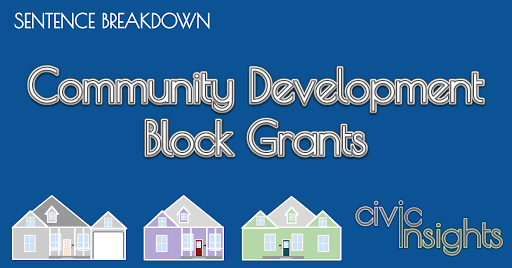Civic Insights: Community Development Block Grants

(City council, school board, planning commission, county commissioners – these groups and several others represent us. They do the day to day work of running our community. It is our responsibility to keep informed about their work so that we can help them represent us effectively. “Civic Insights” by Jeffrey Vitarius is a regular feature of Act Locally Waco. Its purpose is to help us understand decisions that shape our community so that we can participate effectively as informed, engaged residents of Waco. – ALW)
By Jeffrey Vitarius
This week we are going to try to unpack the following sentence: “The City Council held a public hearing as part of a series of public hearings and eventually action regarding the 2020-2021 Annual Action Plan for Community Development Block Grant (CDBG) and HOME Investment Partnership Program (HOME) funding.” Let’s jump right in.
What is Community Development Block Grant (CDBG) and HOME Investment Partnership Program funding?
In the broadest sense, these two programs are funding sources from the federal government to local governments, like the City of Waco, to accomplish certain federal priorities. It is theoretically a way for the federal government to pay for services and projects that advance federal goals without directly managing the programs themselves.
The City’s Consolidated Plan (more on that later) provides a good summary of the goals of each of these programs. The CDBG program is aimed at developing urban communities with decent housing, suitable living environments and economic opportunities for low and moderate-income folks. The HOME program has a more focused mission and is aimed at developing affordable housing (both to rent and to own) for low and moderate-income folks.
In Waco this funding has gone to:
- Rehabilitation of owner-occupied housing (including items like roof repairs)
- Code compliance inspections (making sure that housing is “in code” with the standards the city uses to assess livability)
- Job training
- Emergency Housing
- Down Payment Assistance
- Rental Assistance
- Park Improvements (including at Wilbert Austin Sr. Park, Kendrick Park, Dewey Park, Oscar DuConge Park, South Waco Park, North Waco Park, and Bell’s Hill Park)
For the 2020-2021 fiscal year the Annual Action Plan is anticipating funding of $2,082,261. This is less than 0.5% of the City’s overall budget, but the programs funded in this way are critical to some of Waco’s most challenging problems.
The Consolidated Plan notes that the greatest of these challenges is housing affordability. Generally speaking, housing is considered affordable if housing costs are less than 30% of income. In Waco, 39.1% of households spend more than 30% of their income on housing and 21.06% of households spending over 50% of their income on housing.
What is a Consolidated Plan?
The Consolidated Plan is a long-term (five years) look at how the City will use funding from the CDBG and HOME programs to pursue the goals of those programs. The plan breaks down how it was developed, what needs it identifies, how it anticipates meeting those needs, and what resources and partners will be needed in pursuing the programs it lays out.
The development of a Consolidated Plan is a requirement for pursuing this kind of funding, as is the development of Annual Action Plans.
What is an Annual Action Plan?
An Annual Action Plan takes the five-year nature of the Consolidated Plan and looks at what will occur over the next year. This week, the public hearing was focused on the 2020-2021 Annual Action Plan which is the second such plan under the 2019-2023 Consolidated Plan.
Why did the City Council hold a public hearing on the Annual Action Plan?
Given that the services and projects funded by the CDBG and HOME programs are meant to serve the needs of the public, the development of both Consolidated Plans and Annual Action Plans require a good deal of public input. The need for “citizen participation” is so great in these programs that generating this participation gets a plan of its own.
As Raynesha Hundell, Interim Director of Community Services, presented to City Council this week, the City has pursued citizen input through a number of different routes. While preparing the annual action plan they met with neighborhood associations and gathered approximately one-hundred and sixty surveys on the matter. They used this input to identify priorities for this year’s action plan.
Now that an annual action plan has been drafted, the citizen participation plan requires that there be a thirty-day period where the public may review and comment on the Annual Action Plan. That thirty-day period began on the 10th of this month and will conclude on the 9th of October. The participation plan also requires that a public hearing occur during the thirty-day window for public input. The hearing this week was that hearing.
So, let’s go back to our initial sentence: “The City Council held a public hearing as part of a series of public hearings and eventually action regarding the 2020-2021 Annual Action Plan for Community Development Block Grant (CDBG) and HOME Investment Partnership Program (HOME) funding.” I hope that is a little clearer now. As I feel like I keep saying, there is a lot more to unpack in this topic. The presentation that was made to council this week serves as a great introduction.
What happened at City Council?
City Council was broadly supportive of the draft Annual Action Plan and its program-based approach to distributing funding. Additionally, Council Member Sabido asked follow-up questions regarding the map determining where CDBG and HOME funds could be spent (another interesting topic for a different day).
What comes next?
- To October 9th – Public Comment Period Continues
- September 15th – Draft Annual Action Plan Public Hearing
- October 6th – Draft Annual Action Plan Public Hearing
- October 20th- Annual Action Plan will return to City Council for approval
- October 23rd – Annual Action Plan will be submitted to the Department of Housing and Urban Development (HUD) that oversees the CDBG and HOME programs
Other Interesting (to me) Items From the Agenda
- The planning items that were reviewed by the Plan Commission back in August have now made it to the City Council for their review.
- Now that the budget has been passed, there are a number of resolutions concerning contracts the City will need as it pursues the priorities of that budget. These range from procurement of Microsoft 365 to repairing the elevator at the Zoo’s administration building. As City Manager Bradley Ford noted during the City Council Meeting this week, “This agenda is a great one, as well as the first one in October, to read in order to get an understanding of the breadth and depth of municipal operations.”
- The Downtown PID Service and Assessment Plan we discussed two weeks ago has returned for final approval.
Meeting Basics
- Work Session – 3:00 pm / Business Session – 6:00pm
- To watch the recorded session click here (City of Waco Cable Channel, wccc.tv)
- For the full agenda click here
- For the meeting packet with the documents pertinent to the meeting click here.

Jeffrey Vitarius has been actively local since early 2017. He lives in Sanger Heights with partner (JD) and his son (Callahan). He helped found Waco Pride Network and now serves as that organization’s treasurer and Pride Planning Chair. Jeffrey works at City Center Waco where he helps keep Downtown Waco clean, safe, and vibrant. He is a member of St. Alban’s Episcopal Church and graduated from Baylor in 2011.
The Act Locally Waco blog publishes posts with a connection to these aspirations for Waco. If you are interested in writing for the Act Locally Waco Blog, please email [email protected]for more information.
